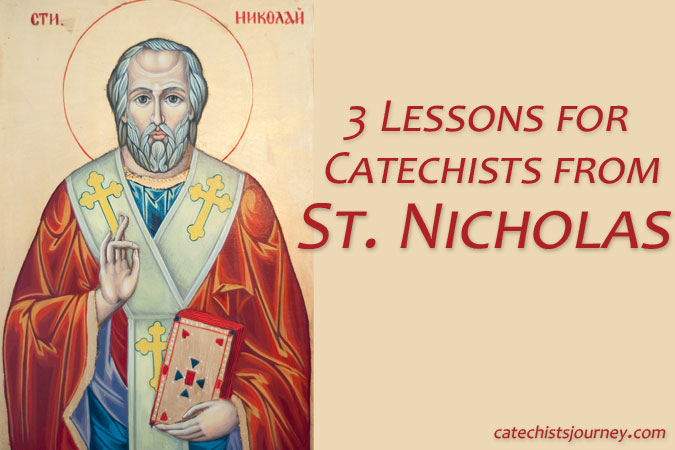
On December 6, we celebrate the Feast of St. Nicholas. On the night of December 5, children leave their shoes by the door, finding them filled with treats when they wake up the next morning. Catechists too can find “treats” from the life of St. Nicholas to help them in their ministry. Here are three lessons we can learn from the life of this fourth-century saint.
1. Be a gift-giver.
St. Nicholas is best known for giving gifts. One popular story tells of a poor man with three daughters who was unable to provide dowries for them. Hearing about their situation, Nicholas went to their house late at night and threw three bags of gold coins through the window of their home. Nicholas’s gifts ensured the future security of these three young women.
We catechists give many gifts to the children in our care, primarily our time and talent. This Advent, think about the children in your class. What gifts do they need? Perhaps a child with low self-esteem needs to be recognized for making a contribution to the class. Perhaps a child who loves to have your undivided attention can get exactly that while the rest of the class is working. Give each child a Christmas card with a hand-written note that describes why you love having him or her in your class and what your hopes are for them in the future.
2. Protect children.
After his death, many stories of St. Nicholas began to circulate of his continued protection of children and his ability to restore children to life and return them to their families. In one story, pirates invaded Myra on the eve of St. Nicholas’s feast day and stole treasures from the church. They also kidnapped a young boy named Basilios, who became a slave. St. Nicholas appeared to Basilios and whisked him away, bringing him back to his family’s home.
As catechists, we too are tasked with the protection of children. Not only are we responsible for their physical well-being while they are in our care, but we partner with their parents in the protection of their souls. The reason our parishes dedicate significant amounts of time, energy, and resources to our programs is to lead the children and their families on the path of salvation. We strive to help them translate their faith into action in their daily lives.
3. Defend the faith.
One of my favorite memes of St. Nicholas makes its appearance on social media every year around his feast day: a picture of St. Nicholas with the text, “I came to give presents to kids and to punch heretics. And I just ran out of presents.” At the Council of Nicea in 325, a priest named Arius argued that Jesus was not equal to God the Father. Nicholas became so agitated listening to Arius that he got up and slapped Arius across the face!
While I am not suggesting you begin slapping people with whom you disagree, I am encouraging you to defend your faith. Older children will begin to question what they have been taught, and they are learning how to express their doubts. This is a healthy part of coming to understand and trust the faith. They bring many questions to class and face many challenges from their school peers who are not Catholic. Equip your students to defend their faith. Find out what questions they face, and help them answer them in convincing ways.
What else can we learn from St. Nicholas this Advent?



Hi I love the article.
As a grandma of two 5 year old and three and a half year old the five year old is starting catechism hour-and-a-half class for the sacraments Penance and holy Eucharist….. He is in baseball Little League Soccer Little Big and his sister is in ballet Sat mornings. They get treats Applause trophies pizza parties for all of the above activities. What is a good treat for getting up at 8:30 a.m. Sunday morning and going to catechism class and then Holy Mass on Sunday morning? Without seeming like it’s just one of the other secular activities.
Please email me with any ideas thank you so much!!! Loretta Garcia